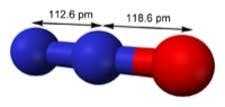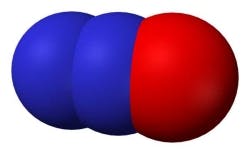Nitrous oxide/oxygen sedation has been safely used in dentistry for many years
By Maria Perno Goldie, RDH, MS
Early use of nitrous oxide dates back to 1794. Nitrous oxide/oxygen sedation has been safely used in the dental office for many years as an analgesic agent to alleviate patient anxiety and diminish dental pain. A practicing dental hygienist or dentist may choose to use nitrous oxide/oxygen sedation in their office and should know the impact that this choice will have on patients, the operator, others in the office, and the environment. Dental hygienists and dentists need to be educated to safely and effectively administer nitrous oxide/oxygen sedation as a pain and anxiety control strategy in practice. This article will list resources for further study.
Early use of nitrous oxide dates back to 1794. Nitrous oxide/oxygen sedation has been safely used in the dental office for many years as an analgesic agent to alleviate patient anxiety and diminish dental pain. A practicing dental hygienist or dentist may choose to use nitrous oxide/oxygen sedation in their office and should know the impact that this choice will have on patients, the operator, others in the office, and the environment. Dental hygienists and dentists need to be educated to safely and effectively administer nitrous oxide/oxygen sedation as a pain and anxiety control strategy in practice. This article will list resources for further study.
The National Institute for Occupational Safety and Health (NIOSH) has guidelines for controlling exposures of workers to nitrous oxide (N2O) during the administration of anesthetic gas in medical, dental, and veterinary operatories. NIOSH concluded in 1977 that exposure to N2O causes decreases in mental performance, audiovisual ability, and manual dexterity.(1,2) A study of workers and several experimental animal studies indicate that adverse reproductive effects may also result from chronic exposure to N2O.(3,4,5,6,7) They issued an alert in 1994 that presented control measures for preventing or greatly reducing exposure to N2O during the administration of anesthetic gas. These control measures should be part of a comprehensive written safety and health plan for workers. NIOSH requests that safety and health officials, editors of appropriate journals, manufacturers of anesthetic equipment, union representatives, employers, and managers bring the recommendations in this Alert to the attention of all workers who are at risk.(8)A one page NIOSH alert outlines steps to be taken to protect yourself from N2O in the office.(9) The American Dental Association (ADA) has an Association Report entitled: “Nitrous Oxide in the Dental Office” and provides tips and recommendations for safe and effective use of this sedation agent.(10)If using this modality, you should know the properties of nitrous oxide and be able to identify the effects of nitrous oxide on pain, anxiety, and the body systems. Knowing the indications and relative contraindications for the use of nitrous oxide/oxygen sedation is crucial for patient and operator safety. You should also recognize signs and symptoms of ideal sedation and over sedation, and appropriate recovery from nitrous oxide/oxygen sedation.
Clinicians should be able to distinguish particulars associated with chronic exposure to nitrous oxide, and be familiar with methods for detection and assessment of trace levels of nitrous oxide in the office and methods of minimizing those levels. Understanding the equipment associated with nitrous oxide/oxygen sedation, and being able to use the proper technique for nitrous oxide/oxygen sedation is important for health, safety, and efficacy of treatment.It is important for us to understand the effect of N2O on the environment. The chemical formula for nitrous oxide is N2O. The elements that make up N2O, nitrogen and oxygen, are the two most abundant elements in the earth's atmosphere. Nearly 99 percent of the earth's atmosphere is nitrogen and oxygen. There is not enough N2O in the atmosphere to affect us, as what we use in the office is 50 percent O2 and 50 percent N2O, a very concentrated mixture compared to the air we breathe. There isn't enough N2O in the atmosphere to cause us to be sedated, but N2O is extremely efficient at warming the atmosphere. One molecule of N2O has 200 to 300 times the greenhouse warming effect of CO2, the primary greenhouse gas. In order to cut down on ozone depletion we should use this substance judiciously.(11)Nitrous oxide/oxygen sedation, N20-02, was typically administered by dentists through a demand-valve inhaler over the nose that only releases gas when the patient inhales through the nose; full-face masks are not commonly used by dentists, so that the patient's mouth can be worked on while the patient continues to inhale the gas. Current use involves constant supply flowmeters which allow the proportion of nitrous oxide and the combined gas flow rate to be individually adjusted.
The masks still obviously cover only the nose. Because nitrous oxide is minimally metabolized, it retains its potency when exhaled into the room by the patient and can pose an intoxicating and prolonged-exposure hazard to the office staff if the room is poorly ventilated. Where nitrous oxide is administered, a continuous-flow fresh-air ventilation system or nitrous-scavenging system is used to prevent waste gas buildup.The principal advantage to the use of nitrous oxide-oxygen is the rapidity with which the sedation takes effect. The onset of action of inhalation sedation is less than 20 seconds which is almost equal to that of intravenous medications. Compare this to the 30-minute onset period for other types of sedation. Because nitrogen oxide is not metabolized by the body, the gas is rapidly and virtually completely eliminated from the body within 3 to 5 minutes. For an excellent review of the technique for administration, indications and contraindications, and other information, visit the website listed.(12)In over half the of the states in the USA, dental hygienists are legally able to administer or monitor N20-02 sedation. This list can be found in the Members section of www.adha.org or contacting the appropriate ADHA staff member.
The Handbook of Nitrous Oxide and Oxygen Sedation, by Morris S. Clark, DDS, FACD, and Ann Brunick, RDH, MS, now in its second edition, is marketed as a chairside reference guide for oral health care and other health professionals to use in the delivery of nitrous oxide sedation. The book was reviewed by Ann Eshenaur Spolarich, RDH, PhD, for the Journal of Dental Hygiene (JDH).(13) Dr. Spolarich stated the book is written in a concise and bulleted format to facilitate reading and to locate information quickly and easily. This edition has been expanded from the original and now includes additional detailed information about the effects of nitrous oxide on various body systems and special multidisciplinary applications. A review of the American Society of Anesthesiologists (ASA) classification guidelines is included to assess patients with medical risk who may be candidates for sedation. It is available on a number of websites.(14,15)Dental hygiene and dental professionals find that N2O/O2 is a reliable and efficient method of relieving pain, fear, and apprehension in patients undergoing surgical procedures. It quickly and easily reversed without unwanted side effects. There are numerous resources available for this method of sedation. Step-by-step techniques of all the uses of N2O/O2 as a means of pain and anxiety management can be found for students and professionals of all levels.References
1. NIOSH respirator decision logic. Cincinnati, OH: U.S. Department of Health and Human Services, Public Health Service, Centers for Disease Control, National Institute for Occupational Safety and Health, DHHS (NIOSH) Publication No. 87B108. 2. Criteria for a recommended standard: occupational exposure to waste anesthetic gases and vapors. Cincinnati, OH: U.S. Department of Health, Education, and Welfare, Public Health Service, Center for Disease Control, National Institute for Occupational Safety and Health, DHEW (NIOSH) Publication No. 77B140.3. Rowland AS, Baird DD, Weinberg CR, Shore DL, Shy CM, Wilcox AJ [1992]. Reduced fertility among women employed as dental assistants exposed to high levels of nitrous oxide. New Eng J Med 327(14):993B997.4. Corbett TH, Cornell RG, Endres JL, Millard RI [1973]. Effects of low concentrations of nitrous oxide on rat pregnancy. Anesthesiology 39:299B301.5. Vieira E [1979]. Effect of the chronic administration of nitrous oxide 0.5% to gravid rats. Br J Anaesth 51:283B2876. 6. Vieira E, Cleaton-Jones JP, Austin JC, Moyes DG, Shaw R [1980]. Effects of low concentrations of nitrous oxide on rat fetuses. Anesth and Analgesia 59(3):175B177.7. Vieira E, Cleaton-Jones P, Moyes D [1983]. Effects of low intermittent concentrations of nitrous oxide on the developing rat fetus. Br J Anaesth 55:67B69.8. www.cdc.gov/niosh/noxidalr.html. 9. Alert: request for assistance in controlling exposures to nitrous oxide during anesthetic administration. Cincinnati: U.S. Department of Health and Human Services, Public Health Service, Centers for Disease Control, National Institute of Occupational Safety and Health, 1994. www.cdc.gov/niosh/pdfs/94-100sum.pdf. 10. Nitrous oxide in the dental office. ADA Council on Scientific Affairs; ADA Council on Dental Practice. J Am Dent Assoc 1997 128: 364-365.11. Ledley, T.S., E.T. Sundquist, S.E. Schwartz, D.K. Hall, J.D. Fellows, and T.L. Killeen, Climate change and greenhouse gases, Eos, 80 (39), 453-474, 1999.12. www.homesteadschools.com/dental/courses/NitrousOxide/text.htm.13. Spolarich AE. Review of: Handbook of Nitrous Oxide and Oxygen Sedation. Journal of Dental Hygiene, Vol. 78, No. 4, Fall 2004.14. www.elsevier.com/wps/find/bookdescription.cws_home/712585/description#description. 15. www.amazon.com/Handbook-Nitrous-Oxide-Oxygen-Sedation/dp/0323019773. Additional Reading
1. Babl, Franz E., Oakley, Ed, Seaman, Cameron, Barnett, Peter, Sharwood, Lisa N. High-Concentration Nitrous Oxide for Procedural Sedation in Children: Adverse Events and Depth of Sedation Pediatrics 2008 121: e528-e532.
1. NIOSH respirator decision logic. Cincinnati, OH: U.S. Department of Health and Human Services, Public Health Service, Centers for Disease Control, National Institute for Occupational Safety and Health, DHHS (NIOSH) Publication No. 87B108. 2. Criteria for a recommended standard: occupational exposure to waste anesthetic gases and vapors. Cincinnati, OH: U.S. Department of Health, Education, and Welfare, Public Health Service, Center for Disease Control, National Institute for Occupational Safety and Health, DHEW (NIOSH) Publication No. 77B140.3. Rowland AS, Baird DD, Weinberg CR, Shore DL, Shy CM, Wilcox AJ [1992]. Reduced fertility among women employed as dental assistants exposed to high levels of nitrous oxide. New Eng J Med 327(14):993B997.4. Corbett TH, Cornell RG, Endres JL, Millard RI [1973]. Effects of low concentrations of nitrous oxide on rat pregnancy. Anesthesiology 39:299B301.5. Vieira E [1979]. Effect of the chronic administration of nitrous oxide 0.5% to gravid rats. Br J Anaesth 51:283B2876. 6. Vieira E, Cleaton-Jones JP, Austin JC, Moyes DG, Shaw R [1980]. Effects of low concentrations of nitrous oxide on rat fetuses. Anesth and Analgesia 59(3):175B177.7. Vieira E, Cleaton-Jones P, Moyes D [1983]. Effects of low intermittent concentrations of nitrous oxide on the developing rat fetus. Br J Anaesth 55:67B69.8. www.cdc.gov/niosh/noxidalr.html. 9. Alert: request for assistance in controlling exposures to nitrous oxide during anesthetic administration. Cincinnati: U.S. Department of Health and Human Services, Public Health Service, Centers for Disease Control, National Institute of Occupational Safety and Health, 1994. www.cdc.gov/niosh/pdfs/94-100sum.pdf. 10. Nitrous oxide in the dental office. ADA Council on Scientific Affairs; ADA Council on Dental Practice. J Am Dent Assoc 1997 128: 364-365.11. Ledley, T.S., E.T. Sundquist, S.E. Schwartz, D.K. Hall, J.D. Fellows, and T.L. Killeen, Climate change and greenhouse gases, Eos, 80 (39), 453-474, 1999.12. www.homesteadschools.com/dental/courses/NitrousOxide/text.htm.13. Spolarich AE. Review of: Handbook of Nitrous Oxide and Oxygen Sedation. Journal of Dental Hygiene, Vol. 78, No. 4, Fall 2004.14. www.elsevier.com/wps/find/bookdescription.cws_home/712585/description#description. 15. www.amazon.com/Handbook-Nitrous-Oxide-Oxygen-Sedation/dp/0323019773. Additional Reading
1. Babl, Franz E., Oakley, Ed, Seaman, Cameron, Barnett, Peter, Sharwood, Lisa N. High-Concentration Nitrous Oxide for Procedural Sedation in Children: Adverse Events and Depth of Sedation Pediatrics 2008 121: e528-e532.
Maria Perno Goldie, RDH, MS
To read previous articles in RDH eVillage FOCUS from 2011 written by Maria Perno Goldie, go to articles.







